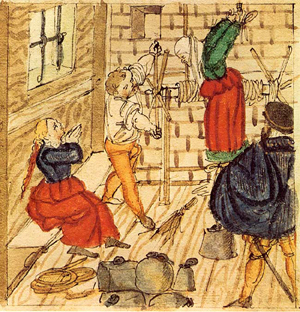 The Hammer of Witches
The Hammer of Witches Image right: A torture scene from the Wickiana. Torture of the wife and daughter of the teamster Hans Ueli, 1577. The wife is being tortured with strappado. Source: Wikimedia Commons. Read for discussion in class: Oldridge, chapter 4.
I. Discussion: The Malleus Maleficarum
II. Intellectual Currents
and the Feminization of Witchcraft
A) Elite (Male) and Popular (Female) Magic
1. The Rise of Learned Magic in the Late Middle Ages
2. Conflating Sorcery and Common Magic
B) From the Seven Deadly Sins to the Ten Commandments
1. Sins against Community versus Sins against God
2. The Transformation of Satan
The Seven Deadly Sins:
Wrath (Ira), Lust (Luxuria), Vanity (Superbia), Sloth
(Accidia), Gluttony (Gula), Avarice (Avaritia), Envy
(Invidia).
.jpg)
Image: The so-called "Madrid tabletop," by Hieronymous Bosch (c. 1453-1525).
On panel, 120 x 150 cm. Museo Nacional del Prado, Madrid. Source: boschuniverse.org.
In this painting, Bosch sought to describe the late medieval conception
of sin. The central element is the all seeing eye of God, with Christ
positioned at the center, in its pupil, giving a blessing; beneath him
is the legend, Cave, Cave, Dominus videt (Beware, beware, the Lord
sees [all]). Around the pupil are arrayed the seven deadly sins with their
Latin names. The four corners of the panel are decorated with scenes of
the Four Last Things: Death (top left), the Last Judgment (top right),
Hell (bottom left), and Heaven (bottom right) [for more information, go
to boschuniverse.org].
.jpg) What
Was Inquisition?
What
Was Inquisition?
.jpg)
.jpg)